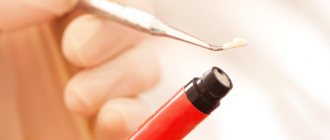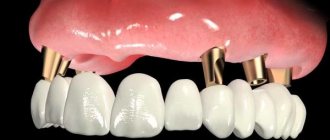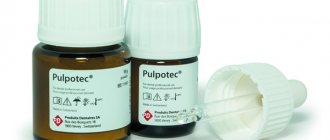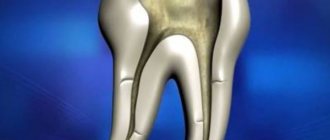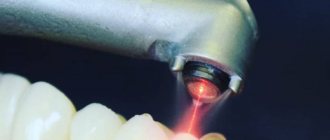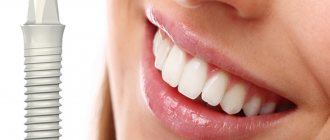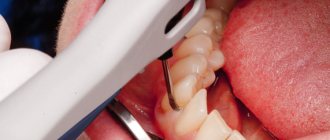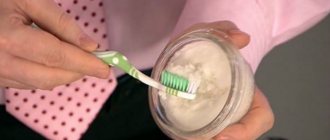August 12, 2018
We hear and know a lot of information about tooth enamel. After all, it is, as it were, its outer shell, protecting the insides from the effects of negative factors and bacteria, completely unfairly forgetting about what is underneath it. And underneath it lies dentin, which is also of great importance for the functionality of each individual tooth and directly affects its appearance and condition.
The photo shows the structure of the tooth
The editors of the UltraSmile.ru portal have specifically tried to collect the most interesting information about dentin, which will help you understand what it is and what its main purpose is.
Fact #1: Gives teeth color.
If you still think that your teeth owe their natural shade to the color of their enamel, then you are deeply mistaken. It is the dentin located under the enamel, which is the inner part of the tooth structure, that determines the original shade of the entire smile. Enamel itself is transparent, despite the fact that it is the strongest part in the human body. But the less dense and softer layer of dentin shines through it. It can be white, but most often it is grayish or yellowish. Its color directly affects the whiteness of the smile.
The shade of teeth largely depends on the color of dentin.
There is no reason to be upset if your smile is not ideally white. Whitening your teeth is not a problem using various methods, but keeping them healthy is much more difficult. For example, owners of naturally yellow teeth (this factor, by the way, can also be hereditary) can count on the fact that their body is fully saturated with minerals, which means it is able to more effectively “fight off” bacteria that try to provoke caries and other diseases oral cavity. As a result, teeth are much stronger than those of those who boast naturally white enamel.
What is dentin
Dentin is a specialized connective tissue that makes up the bulk of the tooth along its entire length. It has much in common with bone tissue, but unlike bone, dentin is more mineralized.
Dentin is considered a calcified substance that contains mineral components. Due to this component of the tooth, micronutrients are carried through the tubules to the enamel, which protect the pulp from various negative influences.
Attention! Dentin refers to the inner part of the tooth. In its structure, it is much stronger and harder than bone tissue, but it is softer than the enamel that covers it. In addition, it has increased elasticity, this property resists its destruction.
The thickness of dentin in the chewing and cervical areas has some differences. Its parameters can be from 2 to 6 mm, it all depends on the health and condition of each patient’s body. In its structure, this component has a yellow or gray tint, which is considered the natural color of teeth. Please note that the dentin coverage varies in different areas of the tooth. In the coronal part, this is enamel, which can be seen during visual inspection. In the root area, this coating is replaced by a cement base, which is not very strong in structure. The connection of dentin to enamel usually occurs due to special irregularities with a perfect fit to each other.
Fact #2: Protects and nourishes the dental pulp
Dentin is a substance unique in its chemical composition, consisting of many, so to speak, “layers” that are designed to protect the “heart” of the tooth or pulp located underneath, as well as nourish it. To understand how it does this, consider its composition:
- predentin: this is exactly the layer that envelops the pulp with all the blood vessels on all sides. It consists of cells called “odontoblasts”. When there is no intervention in the tooth structure, the cells are in a calm state, but as soon as they begin to be affected by infection or bacteria, and the integrity of the enamel is compromised, they become very active, as a result of which we feel pain and discomfort. Simply put, tooth sensitivity directly depends on this layer,
- canals or dentinal tubules: all dentin is penetrated by tubules, through which metabolic processes occur with all other tooth structures, in particular with pulp and enamel. The presence of such channels provides reliable protection of the pulp chamber from the penetration of bacteria and foreign microorganisms into it. The walls of these tubes, by the way, are literally lined with peritubular dentin, which is saturated with a large amount of minerals that provide nutrition to the tooth. What’s interesting is that at birth they are wide, short and straight in almost all people, but with age they begin to lengthen and narrow.
- perimantle layer of dentin: this is the substance that fills all the spaces between the tubules and dentinal tubules. One part of it is adjacent to the enamel, the other to the pulp.
The photo shows dentin - a tooth without enamel
The effectiveness of the technique of immediate sealing of dentin with delayed fixation of restoration
Author: Pascal Magne
Formulation of the problem.
Immediate dentin sealing (IDS) represents a new approach in the field of indirect restorations. Dentin coating is carried out immediately after the tooth preparation stage before the impression taking procedure. It is unknown whether an effective bond between dentin coated with adhesive resin and the restoration can still be achieved after 2 to 4 months of placement of the provisional restorations.
Target.
The purpose of this study was to determine the difference in the adhesion strength of permanent structures to dental dentin using the IDS technique, based on the time interval from preparation to the stage of fixation of the prosthesis (2, 7 and 12 weeks, respectively), using two different dentin bonding agents (DBA). Previously published data on IDS were included for comparative analysis.
Materials and methods.
Fifty extracted human molars were collected and divided into 10 groups. The Optibond FL two-component total etch adhesive system and the SE Bond two-component self-etch adhesive system were used. For each dentin bonding agent, control samples were prepared using the direct immediate bonding technique and restoration with Z100 photocomposite. The remaining specimens were prepared using either an indirect approach technique without dentin prebonding (delayed dentin sealing, DDS) or with immediate dentin sealing (IDS), which was performed immediately after the preparation step. Temporary restorations (Temfil) were placed on teeth with IDS for 2 weeks (IDS-2W), 7 weeks (IDS-7W) and 12 weeks (IDS-12W) before cementing the permanent restorations. All teeth were prepared for a continuous tensile strength test (MTBS) 24 hours after the final restoration with composite onlays (Z100). 10 to 11 sections (0.9 x 0.9 x 11 mm) from each tooth were selected for testing. The MTBS test results from each of the ten experimental groups were collected and analyzed using a two-way ANOVA (dentin bonding system, application sequence), with each tooth (MTBS test results from each of 10–11 sections) being used as an individual measurements. The Tukey HSD (Handily Significant Difference) test was used to detect pairwise differences between experimental groups (α=.05). The sections were also examined under a stereoscopic microscope (x30) and using an SEM analyzer.
Results.
For both adhesive systems, the adhesive strength values of group C and all IDS groups differed slightly and exceeded 45 MPa. The adhesion strength of DDS groups turned out to be lower than that of other variations (P<001), when using SE Bond it was 1.81 MPa, when using Optibond FL it was 11.58 MPa. The highest adhesive force value was obtained in the case of Optibond FL. the following time ranges: 7 weeks (66.59 MPa) and 12 weeks (59.11 MPa). These values were significantly higher compared to SE Bond under similar time conditions with values of 51.96 MPa and 45.76 MPa (P = .001 and P = .003), respectively. The nature of bond destruction in the case of DDS groups turned out to be completely adhesive, since destruction was observed only at the phase interface. Both groups, C and IDS_12W, demonstrated bond failure at the interface between materials, which was usually combined with fracture
Fact #3: helps enamel withstand chewing loads
What is dentin? It is one of the bone structures or tooth bases that is more than 70% mineral. These include calcium, magnesium and sodium. The rest of its composition consists of amino acids, lipids, collagen fibers and water. This is a very durable, but at the same time incredibly elastic and elastic1 natural material. Thanks to such reliable support, our enamel easily takes on the load during the process of chewing food and maintains its integrity even under the influence of hard foods and mechanical factors.
Symptoms of carious dentin lesions
The occurrence of the following symptoms should be a reason to consult a doctor.
- The process of chewing food causes discomfort and pain.
- The occurrence of unpleasant sensations when the tooth surface is exposed to external irritants - hot or cold food, flavoring agents.
- The appearance of a depression in the tooth that is felt or detected upon examination.
- Unpleasant odor from the mouth.
- Unpleasant appearance of teeth.
If you begin to feel discomfort in the tooth area, you should immediately contact your dentist.
Soreness can occur due to the influence of one factor or several.
Important! A distinctive feature of the development of this form of caries is the short duration of pain: they disappear immediately after the irritant is removed.
Fact #4: Dentin varies throughout life.
You now roughly understand what dentin is. But only a few know that it varies throughout our entire lives. Experts identify primary dentin - this is what we received in the process of intrauterine development; it remains in the body until the moment when a baby’s deciduous bite begins to form and appear.
Secondary is formed when teeth erupt above the gum. It is also called substitute. It persists throughout life.
Caries damages teeth
Tertiary is typical for those people who are faced with oral diseases. Any inflammatory process, in particular the onset of caries, serves as a definite signal to action for dentin. As a result, it begins to produce protective tissue, which for some time serves as a reliable safety net for the preservation of the pulp from bacterial attack (the tubules begin to be arranged chaotically). However, this cannot last indefinitely, and if a person does not seek professional help from a dentist and does not cure the disease, then the infection spreads into the tissues, causing their necrosis. Here there will be only one way out - to remove the damaged tissue, and perhaps say goodbye to the pulp, which will also lead to a stop in the metabolic processes in the dentin. Everything is interconnected here.
Secondary (irregular) dentin
Secondary (irregular) dentin . As we have already indicated, dentin deposition does not stop in adult teeth and can occur, although at a slower pace, throughout life. Such dentin, which arose after the teeth erupted and began to function, is called secondary. In addition to the slower rate of formation, it differs from primary dentin (which arose during the embryonic development of the tooth) in having a less regular structure. This is expressed in a change in the course and number of dentinal tubules π collagen fibrils, in disturbances in the nature of calcification (sometimes stronger, sometimes, on the contrary, insufficient), etc. Often, deposits of secondary dentin are separated from previously formed, primary, by a dark line of increased calcification.
The production of secondary dentin sharply increases with various irritations of Toms fibers associated with the destruction or abrasion of enamel and exposure of dentin substance (caries, increased tooth abrasion, preparation of a cavity in the tooth, etc.). In these cases, in areas of the pulp corresponding to the area of tooth damage, there is deposition of more or less significant masses of secondary, or replacement, dentin, which can protrude into the tooth cavity and change its configuration (Fig. 64 and 65).
The resulting dentin usually has a rather variegated structure. Along with canalized areas, there are areas devoid of tubules, consisting only of the main substance. The arrangement of collagen fibers is also disrupted. Such dentin is called irregular, that is, lacking a regular structure. Many authors believe that the formation of secondary or irregular dentin begins when a carious lesion reaches the dentin-enamel boundary and causes irritation of Toms fibers of the most superficial layers of dentin. However, Langeland, who studied 5 teeth with superficial caries, could not establish secondary dentin deposits. The reaction of the pulp was limited in these cases by the accumulation of inflammatory infiltrate cells (leukocytes, lymphocytes and plasma cells) at the level of the lesion. Only when a cavity formed in the dentin in the adjacent sections of the pulp did he observe the formation of irregular dentin. These differences of opinion regarding the time of formation of secondary dentin during caries depend to a large extent on differences in the rate of spread of caries, which varies from patient to patient. When caries spreads rapidly, the pulp does not have time to form enough secondary dentin to prevent a rapidly spreading infection. On the other hand, if caries develops slowly, then the odontoblasts produce a certain amount of secondary dentin, which prevents, at least for a certain time, the penetration of infection into the pulp. This is facilitated by the often observed deposition of lime in the dentinal tubules (sclerosation of dentin), as mentioned above.
Pulpitis in children
With pathological abrasion of teeth, caused by their functional overload or depending on any general disturbances of mineral metabolism, the entire crown of the tooth may be worn down almost to the gum. However, if the process of tooth abrasion is slow enough, then the opening of the pulp chamber does not occur. This is explained by the fact that as the crown wears off, the pulp chamber is gradually filled with secondary dentin, which then itself undergoes wear.
With physiological wear of teeth, which occurs in every person with age, yellowish-brown dentin facets surrounded by a white strip of enamel are exposed on the cutting edge of the front teeth and in the area of the chewing tubercles of the molars. This process of abrasion of tooth substance, normally beginning during the fourth decade of a person's life, slowly progresses until old age. Accordingly, secondary dentin is deposited in the pulp horns or near the cutting edge of the incisor crown, causing a slight reduction in the pulp chamber. It is possible that in some cases it can reach complete obliteration of the pulp chamber. However, this is not the rule, and normally constructed pulp can be seen in the teeth of elderly and elderly people.
Fact No. 5: when dentin is damaged, a person begins to experience pain
Are you familiar with such a reaction as pain from eating sweet and salty, cold and hot? So, in the presence of dental problems, this does not always mean that bacteria have reached the pulp, but it definitely means that they have begun to affect the dentin of the tooth. Moderate caries, wedge-shaped tooth defects, and excessive abrasion of enamel can pose a threat to dentin damage.
Enamel wear leads to dentin exposure
Fact #6: Dentin can regenerate
It is a pity that this conclusion has so far been reached only through experiments. Namely, scientists have found that the artificial synthesis of odontoblast cells, of which only dentin in our body consists, is capable of stimulating the healing of dental tissues when they are damaged.
But don’t despair, to prevent dental diseases you can help dentin from the inside by adjusting your diet and enriching it with vitamin and mineral complexes containing magnesium, calcium, phosphorus, as well as vitamins E, B and D.
Vitamins and minerals will help strengthen your teeth from the inside out
Doing this outside is also not forbidden, as it will be good for health: for these purposes, visit the dentist in a timely manner and have your teeth treated, perform professional oral hygiene, decide on remineralizing procedures and fluoridation, use preventive toothpastes. Just don’t forget - for the components of such toothpastes to work, it is recommended to brush your teeth for at least three minutes in a row.
Notice
: Undefined variable: post_id in
/home/c/ch75405/public_html/wp-content/themes/UltraSmile/single-item.php
on line
45 Notice
: Undefined variable: full in
/home/c/ch75405/public_html/wp-content /themes/UltraSmile/single-item.php
on line
46
Rate this article:
( 8 ratings, average: 5.00 out of 5)
prevention
- Zaitsev D.V., Buzova E.V., Panfilov P.E. Strength properties of dentin and enamel. Bulletin of Tambov University. Series: Natural and technical sciences, 2010.
Consulting specialist
Mozhaeva Irina Mikhailovna
Doctor rating: 9.3 out of 10 (7) Specialization: Dentist-therapist Experience: 14 years
Treatment
In mild cases, when tooth sensitivity is aggravated without obvious destruction of the enamel and its damage by caries, it is possible to apply varnishes containing fluoride or special desensitizers to these areas.
To treat caries you need:
- remove softened, modified dentin,
- Fill the resulting cavity with filling material.
Before placing a filling, the hole is disinfected. If the dentin is very sensitive, after drying the treated tooth cavity, sulfide or fluoride paste is rubbed in. Local anesthesia of the tooth is possible. Then a temporary filling made of artificial dentin or gutta-percha is placed. After 24 hours (anterior) or 36-48 hours (posterior), the temporary filling is removed, the cavity is treated and a permanent filling is installed.
Prevention of caries
- Regular (scheduled) sanitation of the oral cavity of schoolchildren and workers employed in hazardous industries. Systematic treatment of diseased teeth, especially in the initial stage of the disease.
- A balanced diet with sufficient amounts of calcium and fluorine salts, as well as vitamins.
- Consumption of products that help ensure the necessary load on the masticatory apparatus.
- Using toothpaste with a high content of fluoride and calcium to brush your teeth. The use of toothpaste for sensitive teeth has a good effect.
Periodontal treatment
There are several ways to treat periodontal disease:
- mechanical or chemical treatment,
- biological or surgical.
Before starting treatment, it is necessary to get rid of irritating factors, for example, overhanging fillings or crowns that penetrate too deeply into the gums.
Mechanical method
Perform curettage - scraping out the gum pockets with a special sharp spoon.
Rinse the gums with an antiseptic and lubricate with an astringent solution.
Biological method
Subcutaneous or local administration of a vaccine prepared from what is separated from the gum pockets (20 injections). In this case, be sure to use antibiotics with novocaine and vitamin B.
Application of anti-ulcerin with fish oil to the edge of the gums.
Tissue therapy – introduction of aloe extract into the transitional fold (20 injections).
Comments
Who would have thought that there is such a structure of the human body as tooth dentin. Very informative. I’m wondering what will happen to the dentin if the nerve in the tooth is removed? How do tooth nerves and dentin interact in general?
Ilya (08/14/2018 at 01:04 pm) Reply to comment
I didn’t even realize that the dentin of a tooth determines its color. I’ve always felt complex about the fact that my teeth are yellow, but it turns out that’s actually a good thing. Please tell us about remineralizing procedures. What is this anyway?
Egor (08/14/2018 at 02:57 pm) Reply to comment
I’m 62, and this article about tooth dentin made me experience a long-forgotten feeling of discovering new knowledge. Thank you. A friend of mine is over 30, but she still grows new teeth instead of lost ones. Is it related to dentin?
Ivan Leonidovich (08/14/2018 at 17:21) Reply to comment
Of course, I knew what dentin was, but here I learned so many new and interesting facts. I was especially surprised that it varies throughout life, generally useful information. I just wanted to know how often you should go to the dentist?
Konstantin (08/14/2018 at 17:33) Reply to comment
Wow, I didn’t even think that the dentin of a tooth had such a complex structure with several layers; at school everything was explained in a more simplified way. And with what hardness of a brush is it advisable to brush your teeth?
Christina (08/14/2018 at 05:45 pm) Reply to comment
Live and learn. I also thought that the color comes from the tooth enamel. I am also interested in what “remineralizing procedures” are? I hope this doesn't hurt? How long does the procedure take?
Inna (08/16/2018 at 05:51 pm) Reply to comment
There are a lot of interesting facts about tooth dentin, it was interesting to read, it’s good that dentin has the ability to regenerate, and what vitamin complexes should you take for this?
Vika (08/16/2018 at 07:53 pm) Reply to comment
If the whiteness of teeth depends solely on the dentin of the tooth, then how to explain modern whitening technology? After all, this procedure is exclusively superficial, without penetration?
Galina (08/16/2018 at 08:56 pm) Reply to comment
The enamel on my front teeth has worn away and the dentin of the tooth has become visible. Tell me if this needs to be treated somehow to stop tooth decay. I drink calcium all the time, but it is poorly absorbed by the body.
Igor (08/16/2018 at 09:02 pm) Reply to comment
It turns out that tooth dentin is the tissue that nourishes both the enamel and pulp of the tooth. How is dentin itself nourished, and where does it get its nutrients? Dentin cannot be an isolated structure from the whole organism, can it?
Sergey (08/30/2018 at 12:37 pm) Reply to comment
I didn’t even know that tooth dentin can be different. I have naturally yellowish teeth, and at first I was even shy, but now I understand that there is nothing to be shy about. So they are strong for me.
Anastasia (11/21/2018 at 07:13 pm) Reply to comment
It was very interesting to me. I didn’t know that tooth enamel is transparent, and we owe the color of teeth to dentin. I'm wondering how we can help dentin keep our teeth in good condition?
Julia (11/21/2018 at 10:29 pm) Reply to comment
As I understand it, caries destroys the dentin of the tooth. Dentin initially struggles, and then simply gives way to the disease. I now have early stage caries, if I go to the doctor now, will this save my secondary dentin?
Olga (11/21/2018 at 10:34 pm) Reply to comment
I have no doubt about the health of my teeth. But their yellow tint bothers me, although I lead a healthy lifestyle. If I decide to whiten. Will this damage the dentin of the teeth? And which whitening treatment is better to decide on?
Ksenia (11/21/2018 at 10:38 pm) Reply to comment
Write your comment Cancel reply
Carious lesion of dentin - what is it?
The base of the tooth is its hard part, which is called “dentin”. The coverage of different parts of the tooth is excellent: the crown is covered with enamel, and the roots are covered with cement. There are no significant differences between carious lesions of the dentin component and tooth enamel; in the first and second cases, it is destroyed and a cavity is formed. When the pathological process just begins to develop, only the enamel is damaged.
A carious stain is the initial stage of caries, affecting the tooth enamel, and develops due to the leaching of minerals.
Important! At this stage, caries does not cause any noticeable inconvenience; eliminating it is quite simple.
A rather pleasant fact is that you can get rid of such a stain without the help of dental instruments; you do not need to resort to drilling and filling. To restore damage, at the initial stage it is enough to cover the surface of the tooth with substances that can replenish the supply of lost minerals.
At the initial stage of caries, a carious spot appears
Ignoring the initial signs of carious lesions leads to complications of the disease, when the lesion penetrates deeper and affects the hard tissues that are the base of the tooth. In this case, dentin caries develops. This disease is infectious in nature. It develops quite quickly due to the loose structure of the tissues.
Microbes and bacteria present in the oral cavity easily penetrate the dentin layers, causing rapid caries and destruction. The cavity that subsequently forms is quite sensitive. When it is exposed to hot or cold food or liquid, intense pain may occur, which weakens as the exposure to irritating factors ceases.
Important! A person who has experienced these sensations must understand that the disease itself will not go away, the pain will return, and it cannot be done without proper treatment.
The resulting cavity is highly sensitive

